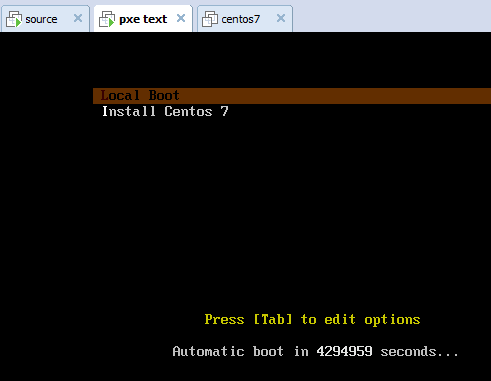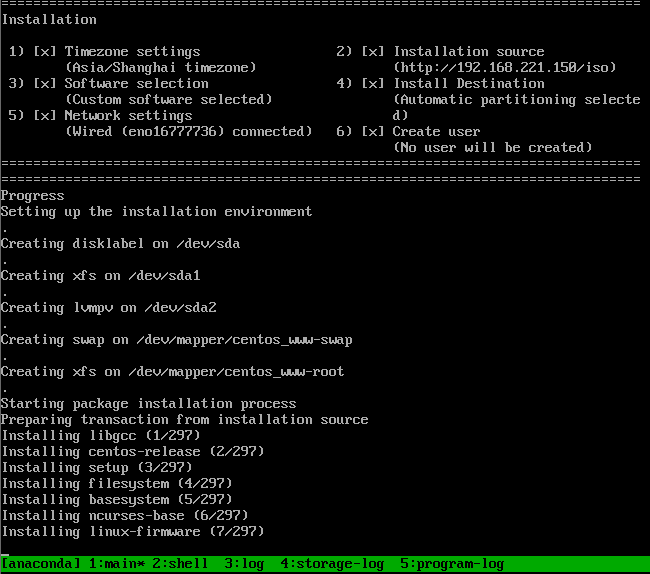The pxe installation server written before forwarding: http://www.attacker.club/article/125
Service list
dhcp: Assign IP addresses, specify startup files and tftp service addresses tftp-server: Transfer boot file http: Publish the iso image of CD-ROM
pxelinux.0: The startup file of the system pxe is obtained by installing the syslinux package Ks.cfg: Customize your own parameters through / root/anaconda-ks.cfg. If you have a graphical interface, you can install kickstart to generate automated files.
Looking at the assigned address, I start the vm-allocated ip here, which can stop vm dhcp. The production environment can find the host according to mac and order and log in ssh.
cat /var/lib/dhcpd/dhcpd.leases #Client IP Address Recording
Design sketch
Stopping interface

<!--more-->
setup script

Boot host

Script
#!/bin/bash # -------------------------------------------------- #Publisher: Who is the Teacher #Email: admin@attacker.club #Website: ops.attacker.club #Description: Centos server initialization # -------------------------------------------------- mkdir -p /pxe/iso >/dev/nell 2>&1 ####---- Mounted mirroring ----#### mount /dev/cdrom /pxe/iso >/dev/nell 2>&1 #Mirror mount if [ ! -d /pxe/iso/Packages ]; then echo echo -e "\033[41;36m mount failed ! CD-ROM is not detected !\033[0m" echo exit fi ####---- Set up ip And segment variables ----#### read -p "Please enter the IP address": IPADDR mask=$(echo $IPADDR| cut -d '.' -f 1-3) ####---- local yum library ----#### mv /etc/yum.repos.d/*repo . cat > /etc/yum.repos.d/local.repo<<EOF [base] baseurl=file:///pxe/iso enable=1 gpgcheck=0 EOF yum clean all ####---- yum Install all services ----#### yum install dhcp tftp-server httpd syslinux net-tools -y mv *repo /etc/yum.repos.d/ >/dev/nell 2>&1 rm /etc/yum.repos.d/local.repo -rf #Restore the original yum library configuration yum clean all subnet=$(ifconfig |grep $IPADDR| awk '{print $4}') router=$(route |grep default|awk '{print $2}') ####---- dhcp To configure ----#### cat >/etc/dhcp/dhcpd.conf<<EOF subnet $mask.0 netmask $subnet { range dynamic-bootp $mask.10 $mask.60; option routers $router; filename "pxelinux.0"; next-server $IPADDR; } EOF ####---- tftpd To configure ----#### sed -i 's#/var/lib/tftpboot#/pxe/tftpboot#g' /etc/xinetd.d/tftp sed -i 's/disable.*$/disable = no/g' /etc/xinetd.d/tftp mkdir /pxe/tftpboot >/dev/nell 2>&1 cp /usr/share/syslinux/pxelinux.0 /pxe/tftpboot/ cp /pxe/iso/isolinux/vmlinuz /pxe/tftpboot/ cp /pxe/iso/isolinux/initrd.img /pxe/tftpboot/ cp /pxe/iso/isolinux/boot* /pxe/tftpboot/ cp /pxe/iso/isolinux/vesamenu.c32 /pxe/tftpboot/ mkdir /pxe/tftpboot/pxelinux.cfg >/dev/nell 2>&1 cat >/pxe/tftpboot/pxelinux.cfg/default<<EOF default vesamenu.c32 timeout 6000 #Timeout-1 residence interface display boot.msg menu background splash.jpg label localhost menu label ^Local Boot menu default localboot 0x80 label linux menu label ^Install Centos 7 kernel vmlinuz append initrd=initrd.img ks=http://$IPADDR/ks.cfg EOF chmod o+rwx /pxe/tftpboot/ -R ####---- http To configure ----#### sed -i 's#/var/www/html#/pxe#g' /etc/httpd/conf/httpd.conf ####---- ks.cfg Automatic script ----#### cat >/pxe/ks.cfg<<EOF text url --url http://$IPADDR/iso firstboot --enable ignoredisk --only-use=sda keyboard --vckeymap=us --xlayouts='us' lang en_US.UTF-8 network --bootproto=dhcp --device=eno16777736 --ipv6=auto --activate network --hostname=www.to-share.net rootpw 123456 #root password timezone Asia/Shanghai --isUtc bootloader --location=mbr --boot-drive=sda autopart --type=lvm clearpart --all --initlabel reboot #Installation package %packages [@core](https://my.oschina.net/u/614730) net-tools %end #Execute scripts after installation %post --interpreter=/bin/bash chmod +x /etc/rc.local echo /root/echo_ip.sh >> /etc/rc.local cat >/root/echo_ip.sh<<Local-IP #!/bin/bash network_dir=/etc/sysconfig/network-scripts/ifcfg-eno16777736 echo >/etc/issue echo "Server IP: \$(ip add |grep global |head -1|awk '{print \$2}'|cut -d / -f 1)" >>/etc/issue echo >>/etc/issue sed -i 's#none#static#g' \$network_dir echo "IPADDR=\$(ip add |grep global |head -1|awk '{print \$2}'|cut -d / -f 1)" >> \$network_dir echo "NETMASK=$subnet" >> \$network_dir echo "GATEWAY=$router" >> \$network_dir echo "DNS1=223.5.5.5" >> \$network_dir echo "DNS2=114.114.114.114" >> \$network_dir echo >>/etc/issue sed -i '14d' /etc/rc.local sed -i '14d' /etc/rc.d/rc.local #Delete 14 rows reboot Local-IP chmod +x /root/echo_ip.sh #/root/echo_ip.sh %end EOF ####---- Startup service ----#### service xinetd restart >/dev/nell 2>&1 service dhcpd restart >/dev/nell 2>&1 service httpd restart >/dev/nell 2>&1 service iptables stop >/dev/nell 2>&1 systemctl stop firewalld >/dev/nell 2>&1 setenforce 0 echo echo -e "\t\t\t\t\033[3;032m[OK]\033[0m\n"